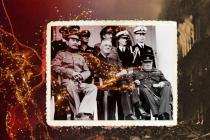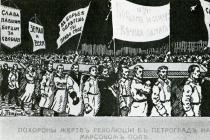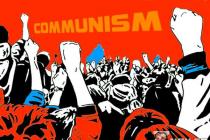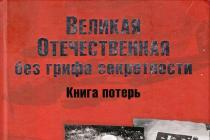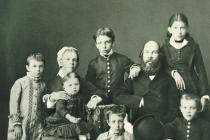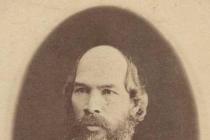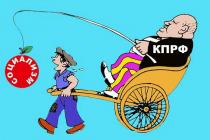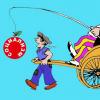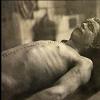They prefer to remember the period of occupation in France as a heroic time. Charles de Gaulle, Resistance ... However, the impartial footage of photo chronicles testifies that everything was not quite the way the veterans tell and write in the history books. These photographs were taken by a correspondent for the German magazine Signal in Paris 1942-44. Color film, sunny days, smiles of the French, welcoming the invaders. 63 years after the war, the selection became the exhibition "Parisians during the Occupation". She caused a huge scandal. The city hall of the French capital has banned its display in Paris. As a result, permission was obtained, but France saw this footage only once. Second, public opinion could no longer afford it. The contrast between heroic legend and truth was too striking.
photo by Andre Zucca from the 2008 exhibition


2. Orchestra on Republic Square. 1943 or 1944
3. Changing of the guard. 1941 year.


5. The audience in the cafe.

6. Beach near the Carrousel Bridge. Summer 1943.


8. Parisian rickshaw.
Regarding the photographs "Parisians during the Occupation". What hypocrisy it is on the part of the city authorities to condemn this exhibition for "lack of historical context"! It is the photographs of the collaborating journalist that perfectly complement other photographs on the same topic, telling mainly about the daily life of Paris during the war. At the cost of collaboration, this city escaped the fate of London, or Dresden, or Leningrad. Carefree Parisians sitting in a cafe or in a park, roller-skating boys and fishermen on the Seine - these are the same realities of wartime France as the underground activities of the Resistance participants. For what it was possible to condemn the organizers of the exhibition, it is not clear. And there is no need for the city authorities to be like an ideological commission under the CPSU Central Committee.

9. Rue Rivoli.

10. Showcase with a photograph of collaborationist Marshal Pétain.

11. Kiosk on Gabrieel Avenue.

12. Metro Marboeuf-Champs Elysees (now - Franklin-Roosevelt). 1943 year.

13. Shoes made of fiber with a wooden shoe. 1940s.

14. Poster of the exhibition at the corner of rue Tilsit and Champs Elysees. 1942 year.

15. View of the Seine from the St. Bernard embankment, 1942.

16. The famous milliners Rosa Valois, Madame le Monier and Madame Agnes during Longshan, August 1943.

17. Weighing the jockeys at the Longshan racetrack. August 1943.

18. At the Tomb of the Unknown Soldier under the Arc de Triomphe, 1942

19. In the Luxembourg Gardens, May 1942.

20. Nazi propaganda on the Champs Elysees. Text on the poster in the center: "THEY GIVE YOUR BLOOD, GIVE YOUR WORK to save Europe from Bolshevism."

21. Another Nazi propaganda poster issued after the bombing of Rouen by British aircraft in April 1944. In Rouen, as you know, the British executed the national heroine of France, Jeanne d'Arc. The inscription on the poster: "KILLERS ARE ALWAYS RETURNING ... TO THE PLACE OF THE CRIME."

22. The caption to the photo says that the bus was fueled by "city gas".

23. Two more automonsters during the Occupation. Both pictures were taken in April 1942. The top photo shows a car fueled by charcoal. The bottom picture shows a car running on compressed gas.

24. In the garden of the Palais Royal.

25. Central market of Paris (Les Halles) in July 1942. The picture clearly shows one of the metal structures (as Baltar's pavilions) from the era of Napoleon III, which were demolished in 1969.

26. One of the few black and white photographs of Zucca. It is the national funeral of Philippe Henrio, Secretary of State for Information and Propaganda, who advocated full cooperation with the occupiers. On June 28, 1944, Enrio was shot and killed by members of the Resistance movement.

27. Playing cards in the Luxembourg Gardens, May 1942

28. The audience in the Luxembourg Gardens, May 1942

29. In the Parisian Central Market (Les Halles, the very "belly of Paris") they were called "meat breeders".

30. Central Market, 1942


32. Central Market, 1942

33. Central Market, 1942

34. Rue de Rivoli, 1942

35. Rue Rosier in the Jewish quarter of Marais (Jews were required to wear a yellow star on their chest). 1942 g.

36. in the Nation quarter. 1941 g.

37. Fair in the Nation quarter. Pay attention to the funny carousel arrangement.

After the previous entry about the Parisian Immortal Regiment, a discussion arose: is it celebrating the Victory here, what was the occupation and liberation for the Parisians? I do not want to give unambiguous answers, as well as to draw any conclusions. But I propose to listen to eyewitnesses and see them through their eyes.
German soldiers look at Paris from the Eiffel Tower, 1940
Robert Capa. Parisians at the Victory Parade, 1944
Here are some dry numbers.
- France was defeated by the Germans in a month and a half. In the First World War, she fought for 4 years.
- During the war, 600 thousand Frenchmen died. In the First World War, the deaths were one and a half million.
- The Resistance movement was attended by 40 thousand people (of which about half are French)
- The troops of De Gaulle's "Free French" in 1943 numbered up to 80 thousand people (of which about 40 thousand were French), by the time of the landing in Normandy they had reached 400 thousand.
- Up to 300 thousand French served in the German Wehrmacht (of which 23 thousand were taken prisoner).
- 600 thousand Frenchmen were deported to Germany for forced labor. Of these, 60 thousand died, 50 thousand were missing, 15 thousand were executed.
And any big whole is better perceived through the prism of small events. I will cite two stories of my good acquaintances who were children in occupied Paris.
Alexander Andreevsky, the son of a white émigré.
Alexander's mother was Jewish. With the arrival of the Germans, the French began to hand over the Jews or to point out to the Germans people they were suspected of being Jews. "Mother saw how neighbors began to look askance at her, she was afraid that they would soon report on her. She went to the old rabbi and asked what she should do. He gave an unusual advice: go to Germany, work there for several months and return with documents that the Germans will give out. But so that when entering Germany the mother's passport would not be checked, the rabbi told her to overturn a jar of honey in her bag. She did so, and the German officer at the border disdained to take documents stained and stuck together from honey. For four months I lived with friends, and then the mother returned from Germany and no one else had any suspicions towards her. "
Françoise d "Origny, hereditary aristocrat.
“During the occupation, we lived in the suburbs, but my mother sometimes took me to the city with her. In Paris, she always walked hunched over, quietly like a mouse, looking at the ground and not looking up at anyone. And she also made me walk. But Once I saw a young German officer looking at me and smiled back at him - I was 10 or 11. My mother instantly gave me such a slap in the face that I almost fell. I never looked at the Germans again. we were traveling in the subway and there were many German officers and soldiers around. Suddenly a tall man called out to my mother, she was very happy, all straightened up and seemed to look younger. The carriage was overcrowded, but an empty space appeared around us, such a breath of strength and independence. then she asked who this man was. Mother answered - Prince Yusupov. "
Take a look at some photographs about the life of the occupation and liberation of Paris. Choosing them, I tried to cover different sides of the events of that time.
1. German victory parade at the Arc de Triomphe in June 1940 
2. Installation of German signs on the Concorde Square. 
3. Chaillot Palace. The oath of civil servants and police to the new government 
4. Champs Elysees, "New Life", 1940 
5. German agitation truck in Montmartre. Music broadcast to commemorate the 30 days of the capture of Paris. July 1940 
6. German soldier with a Frenchwoman in the Trocadero square 
7. In the Paris metro 
8. German newspaper saleswoman 
9. Andre Zyukka. Hot Day, Seine Embankment, 1943 
10. André Zyukka. Parisian women of fashion. 1942 
11. Tuileries Garden, 1943 
12. Return to horse-drawn traction. There was almost no fuel in the city 
13. Wedding in Montmartre 
14. Pierre Zhaan. Melting of monuments into metal. 1941 
15. Sending workers to Germany. 
16. Deportation of Jews, 1941 
17. "Departure from Bobigny". From this station, the trains went straight to the death camps. 
18. At the walls of the Louvre. Food was distributed according to ration cards, so many planted vegetable gardens. 
19. Queue at the bakery on the Champs Elysees 
20. Serving Free Soup 
21. Entrance to the Paris metro - air raid 
22. Legionnaires of the anti-Bolshevik corps 
23. French Volunteer Legion goes to the Eastern Front 
24. Parisians spit on captured British paratroopers, whom the Germans are leading through the city. 
25. Torture of a Resistance member in the German police 
26. Captured members of the Resistance movement are led to execution 
27. Robert Capa. German paratrooper caught by Resistance guerrillas 
28. On the barricade in Paris in August 1944 
29. Paris, August 1944. In the center is Simon Seguan, an 18-year-old guerrilla from Dunkirk. 
30. Robert Capa. Resistance fighters during the liberation of Paris 
31. Shootout with German snipers 
32. Pierre Jamet. Procession of the Leclerc Division, avenue du Maine. Liberation of Paris, August 1944 
33. Robert Capa. Resistance fighters and French soldiers celebrate the liberation of Paris, August 1944 
34. Parisian with allies 
35. Robert Capa. Mother and daughter shaved for cooperation with the invaders. 
36. Robert Capa. Paris welcomes General De Gaulle, August 1944 
German troops on May 10, 1940 launched an offensive against France, which declared war on Germany on September 3, 1939, in connection with the latter's attack on Poland. As a result of the rapid offensive of the German troops, using the tactics of lightning war - blitzkrieg, the allied forces were utterly defeated, and on June 22, France was forced to sign an armistice. By this time, most of its territory was occupied, and practically nothing remained of the army.
The path of German troops to France ran through the lands of Belgium and the Netherlands, which were the first victims of aggression. German troops quickly captured them, defeating the French troops and the British Expeditionary Force that had advanced to help.
On May 25, the commander-in-chief of the French armed forces, General Weygand, said at a government meeting that it was necessary to ask the Germans to accept surrender.
On June 8, German troops reached the Seine River. On June 10, the French government moved from Paris to the Orleans area. Paris was officially declared an open city. On the morning of June 14, German troops entered Paris. The French government fled to Bordeaux.
On June 17, the French government asked Germany for an armistice. On June 22, 1940, France surrendered to Germany, and the Second Armistice of Compiegne was concluded in the Compiegne forest. The armistice resulted in the division of France into an occupation zone of German troops and a puppet state ruled by the Vichy regime.
Tank "Panther" passes next to the Arc de Triomphe in Paris.
German soldiers rest on the shores of the Mediterranean Sea near Toulon. A destroyed French destroyer is visible in the background.

The head of the French collaborationist government, Marshal Henri-Philippe Petain, welcomes French soldiers released from captivity in Germany at the train station in the French city of Rouen.

Ruins of a Renault plant in Paris, completely destroyed by British aircraft.

Portrait of Gestapo Officer SS Obersturmführer Nikolaus Barbie. Chief of the Gestapo of Lyon, where he received the nickname "Executioner of Lyons".

German 88 mm PaK 43 anti-tank gun in occupied Normandy.

German officers at the Horch-901 vehicle in occupied France.

German mounted patrol on a street in Paris.

German troops march through captured Paris.

German soldiers at a street stall in occupied Paris.

Belleville quarter of occupied Paris.

Tank Pz.Kpfw. IV 7th division of the Wehrmacht on the Toulon embankment near the French battleship "Strasbourg".

Place de la Concorde in Paris.

An elderly Jewish woman on a Paris street.

On the Rue des Rosiers in occupied Paris.

Rue Rivoli in occupied Paris.

The Parisians grab the food.

On the streets of occupied Paris. German officers near a street cafe.

On the streets of occupied Paris.

French civilian cars running on coal and gas in Paris. In occupied France, all gasoline went to the needs of the German army.

Weighing jockeys at Longshan Racecourse. Occupied Paris, August 1943

In the Luxembourg Gardens in occupied Paris.

Famous milliners Rosa Valois, Madame le Monier and Madame Agnes race at the Longshan racecourse, August 1943.

Tomb of the Unknown Soldier at the Arc de Triomphe in Paris.

Market Les Halles in occupied Paris.

Cycle taxi at the famous Parisian restaurant "Maxim's".

Parisian fashionistas in the Luxembourg Gardens. Occupied Paris, May 1942.

A Parisian woman on the embankment puts lipstick on her lips.

Showcase with a portrait of the French collaborationist Marshal Pétain in occupied Paris.

German soldiers at a checkpoint at a crossroads near Dieppe.

German officers are exploring the coast of Normandy.

German car "BMW-320" after a collision with a truck "Ford-BB" on the street of a French town.

A column of self-propelled guns Panzerjäger I of the 716th Infantry Division of the Wehrmacht on the march in occupied France.

Two German soldiers on the streets of the occupied French town of Granville.

Two German soldiers in a crashed Sd.Kfz.231 armored car on the road in occupied Normandy.

Column of German troops in Paris.

For a long time, it was believed that this photo captured the execution of a member of the Resistance movement, but the name of the person in the photo was not known, and there was no documentary evidence that executions were carried out in the Belfort fortress (in particular, not a single cartridge case was found on the territory). Many years after the war, Georges Blind's son, Jean, saw this photograph for the first time and recognized his father on it. He said that his father was not shot at Belfort. He was arrested and held in a fortress, and later transferred to a concentration camp in Blechhamer, Upper Silesia, where he died. In prison, the Germans subjected Georges Blind to a mock execution, but did not get any information from him, and sent him to the camp.

German convoy and half-track tractors Sd.Kfz. 10 near the houses of the French village of Suip.

Five Kriegsmarine sailors on the wires of the U-198 submarine at the bunker in La Pallis, France, on the day the boat left for the last combat patrol.

Adolph Hitler and Francisco Franco at negotiations in the French town of Hendaye.

Nazi flag over a street in Paris, 1940.

Adolf Hitler poses with his entourage against the backdrop of the Eiffel Tower in Paris in 1940. Left - Albert Speer, Hitler's personal architect, future Reich Minister of Defense Industry and Armaments. On the right is the sculptor Arno Becker.

Germans are eating on the streets of a French city.

Luftwaffe servicemen with a young French woman at the hippodrome in occupied Paris.

A German soldier at a book counter on a street in occupied Paris.

A section of a street near the Parisiana cinema in occupied Paris.

German units and a military band prepare for a show in occupied Paris.

Citizens of occupied France greet the head of the Vichy collaborationist government, Marshal Henri Philippe Petain.

German officers in a cafe on a street in occupied Paris, reading newspapers, and townspeople. German soldiers passing by greet the seated officers.

Field Marshal E. Rommel with officers oversees the work of the plow during the inspection of the Atlantic Wall.

Adolf Hitler at a meeting with Francisco Franco in the French town of Hendaye. 
A German soldier plows the land with French peasants on a captured Renault UE wedge heel.

German post on the demarcation line dividing occupied and unoccupied France.

German soldiers ride a motorcycle through a destroyed French city.

On the eve of World War II, the French army was considered one of the most powerful in the world. But in a direct clash with Germany in May 1940, the French had enough resistance for a few weeks.
Useless superiority
By the beginning of World War II, France had the 3rd largest army in the world in terms of the number of tanks and aircraft, second only to the USSR and Germany, as well as the 4th navy after Britain, the USA and Japan. The total number of French troops was more than 2 million.
The superiority of the French army in manpower and equipment over the forces of the Wehrmacht on the Western Front was indisputable. For example, the French Air Force included about 3,300 aircraft, of which half were the latest combat vehicles. The Luftwaffe could only count on 1,186 aircraft.
With the arrival of reinforcements from the British Isles - an expeditionary force of 9 divisions, as well as air units, including 1,500 combat vehicles - the advantage over the German forces became more than obvious. Nevertheless, in a matter of months, not a trace remained of the former superiority of the allied forces - the well-trained and tactical superiority of the Wehrmacht army eventually forced France to surrender.
The line that didn't protect

The French command assumed that the German army would act as during the First World War - that is, it would launch an attack on France from the northeast from Belgium. The entire load in this case was to fall on the defensive redoubts of the Maginot Line, which France began to build in 1929 and improved until 1940.
For the construction of the Maginot Line, which stretches for 400 km., The French spent a fabulous sum - about 3 billion francs (or 1 billion dollars). The massive fortifications included multi-level underground forts with living quarters, ventilation and elevators, electrical and telephone exchanges, hospitals, and narrow gauge railways. The gun casemates were supposed to be protected from aerial bombs by a 4-meter-thick concrete wall.
The personnel of the French troops on the Maginot Line reached 300 thousand people.
According to military historians, the Maginot Line, in principle, coped with its task. There were no breakthroughs by German troops in its most fortified sectors. But the German army group "B", bypassing the fortification line from the north, threw the main forces into its new sections, which were being built on swampy terrain, and where the construction of underground structures was difficult. There, the French could not hold back the onslaught of German troops.
Surrender in 10 minutes

On June 17, 1940, the first meeting of the collaborationist government of France, headed by Marshal Henri Petain, took place. It lasted only 10 minutes. During this time, the ministers unanimously voted for the decision to appeal to the German command and ask him to end the war on French territory.
For these purposes, we used the services of an intermediary. The new Minister of Foreign Affairs P. Baudouin, through the Spanish Ambassador Lekeric, sent a note in which the French government asked Spain to ask the German leadership to cease hostilities in France, and also to find out the terms of the armistice. At the same time, a proposal for an armistice was sent to Italy through the papal nuncio. On the same day, Petain on the radio addressed the people and the army, urging them to "stop fighting."
The last stronghold

When the armistice (act of surrender) was signed between Germany and France, Hitler looked with apprehension at the vast colonies of the latter, many of which were ready to continue resistance. This explains some of the relaxation in the treaty, in particular, the preservation of a part of the French navy to maintain "order" in their colonies.
England was also vitally interested in the fate of the French colonies, since the threat of their capture by German forces was highly appreciated. Churchill hatched plans to create an émigré government of France, which would provide de facto control over the French overseas possessions of Britain.
General Charles de Gaulle, who created a government that was opposed to the Vichy regime, directed all his efforts towards conquering the colonies.
However, the North African administration rejected the offer to join the Free French. A completely different mood reigned in the colonies of Equatorial Africa - in August 1940, Chad, Gabon and Cameroon joined de Gaulle, which created the conditions for the general for the formation of the state apparatus.
Mussolini's Fury

Realizing that the defeat of France by Germany is inevitable, Mussolini declared war on her on June 10, 1940. The Italian army group "West" of Prince Umberto of Savoy with over 300 thousand people, supported by 3 thousand guns, launched an offensive in the Alps. However, General Aldrie's opposing army successfully repelled these attacks.
By 20 June, the Italian divisions' offensive had become more fierce, but they had only managed to advance slightly in the Menton area. Mussolini was furious - his plans to capture a large chunk of its territory by the time of France's surrender had failed. The Italian dictator has already begun to prepare an airborne assault, but did not receive approval for this operation from the German command.
On June 22, an armistice was signed between France and Germany, and two days later, France and Italy concluded the same agreement. So, with a "victorious embarrassment" Italy entered the Second World War.
Victims

During the active phase of the war, which lasted from May 10 to June 21, 1940, the French army lost about 300 thousand people killed and wounded. One and a half million were taken prisoner. The tank corps and the French air force were partially destroyed, the other part went to the German armed forces. At the same time, Britain is eliminating the French fleet to avoid falling into the hands of the Wehrmacht.
Despite the fact that the capture of France took place in a short time, its armed forces gave a worthy rebuff to the German and Italian troops. For a month and a half of the war, the Wehrmacht lost more than 45 thousand people killed and missing, about 11 thousand were wounded.
The French victims of the German aggression might not have been in vain if the French government had made a series of concessions put forward by Britain in exchange for the entry of the royal armed forces into the war. But France chose to capitulate.
Paris - a place of convergence 
Under the armistice agreement, Germany occupied only the western coast of France and the northern regions of the country where Paris was located. The capital was a kind of place of "French-German" rapprochement. German soldiers and Parisians lived here peacefully: they went to the cinema together, visited museums or just sat in a cafe. After the occupation, theaters also revived - their box office increased three times compared to the pre-war years.
Paris very quickly became the cultural center of occupied Europe. France lived as before, as if there were no months of desperate resistance and unfulfilled hopes. German propaganda succeeded in convincing many French people that surrender is not a shame for the country, but a road to the "bright future" of a renewed Europe.
Back in the years of World War II, when the north of France was under the occupation forces of Germany, Vichy was the seat of the collaborationist government of free southern France, which became known as the Vichy regime.
Marshal Foch's carriage. Wilhelm Keitel and Charles Hüntziger during the signing of the armistice, June 22, 1940A traitor, an accomplice of the enemy, or in the language of historians - a collaborationist - such people are in every war. During the Second World War, individual soldiers, military units, and sometimes entire states suddenly took the side of those who yesterday bombed and killed them to the side of the enemy. June 22, 1940 was the day of disgrace for France and the triumph of Germany.
After a month of fighting, the French suffered a crushing defeat at the hands of German troops and agreed to an armistice. In fact, it was a real surrender. Hitler insisted that the signing of the armistice take place in the Compiegne forest, in the same carriage in which Germany signed the humiliating surrender in the First World War in 1918.
The Nazi leader was enjoying the victory. He entered the carriage, listened to the preamble of the text of the truce and defiantly left the meeting. The French had to give up the idea of \u200b\u200bnegotiations, an armistice was signed on the terms of Germany. France was divided into two parts, the north, together with Paris, was occupied by Germany, and in the south from the centers in the town of Vichy. The Germans allowed the French to form their new government.
 photo: Philippe Pétain meeting with Adolf Hitler, October 24, 1940
photo: Philippe Pétain meeting with Adolf Hitler, October 24, 1940 By the way, by this time the majority of French citizens were concentrated in the south. The Russian émigré writer Roman Gul later recalled the atmosphere that prevailed in the summer of 1940 in the south of France:
"All the peasants, winegrowers, artisans, grocers, restaurateurs, café garcons and hairdressers and soldiers running like rabble - all wanted one thing - anything, just to end this fall into the bottomless abyss."
Everyone had only one word in their minds, "truce", which meant that the Germans would not go to the south of France, they would not move here, they would not station their troops here, they would not take cattle, bread, grapes, and wine. And so it happened, the south of France remained free, though not for long, very soon and it will be in the hands of the Germans. But while the French were full of hope, they believed that the Third Reich would respect the sovereignty of southern France, that sooner or later the Vichy regime would be able to unite the country, and most importantly, that the Germans would now release almost two million French prisoners of war.
 The head of the French collaborationist government, Marshal Henri Philippe Pétain (1856-1951) welcomes French soldiers released from captivity in Germany at the train station in the French city of Rouen.
The head of the French collaborationist government, Marshal Henri Philippe Pétain (1856-1951) welcomes French soldiers released from captivity in Germany at the train station in the French city of Rouen. All this was to be implemented by the new head of France, who was endowed with unlimited powers. He became a very respected person in the country, the hero of the First World War, Marshal Henri Philippe Petain. At that time, he was already 84 years old.
It was Pétain who insisted on the surrender of France, although the French leadership, after the fall of Paris, wanted to withdraw to northern Africa and continue the war with Hitler. But Pétain offered to end the resistance. The French saw an attempt to save the country from destruction, but finding such a solution turned out to be not salvation, but a disaster. This is the most controversial period in the history of France, not conquered but conquered.
 A group of French prisoners of war follows the streets of the city to the gathering place. In the photo: on the left - French sailors, on the right - Senegalese riflemen of the French colonial troops.
A group of French prisoners of war follows the streets of the city to the gathering place. In the photo: on the left - French sailors, on the right - Senegalese riflemen of the French colonial troops. What policy Pétain would pursue became clear from his speech on the radio. In his address to the nation, he called on the French to cooperate with the Nazis. It was in this speech that Pétain first uttered the word "collaboration", today it is in all languages \u200b\u200band means one thing - cooperation with the enemy. It was not just a bow to Germany, this step Pétain predetermined the fate of the still free southern France.
 French soldiers with raised hands surrender to German troops
French soldiers with raised hands surrender to German troops Before the Battle of Stalingrad, all Europeans believed that Hitler would rule for a long time and everyone had to more or less adapt to the new system. There were only two exceptions, this is Great Britain and of course the Soviet Union, which believed that he would definitely win and defeat Nazi Germany, and all the rest were either occupied by the Germans or were in an alliance.
 The French read Charles de Gaulle's appeal of June 18, 1940 on the wall of a house in London.
The French read Charles de Gaulle's appeal of June 18, 1940 on the wall of a house in London. How to adapt to the new government, everyone decided for himself. When the Red Army was rapidly retreating to the east, they tried to bring industrial enterprises to the Urals, and if they did not have time, they simply blew up so that Hitler did not get a single conveyor belt. The French acted differently. A month after the surrender, French businessmen signed the first contract with the Nazis for the supply of bauxite (aluminum ore). The deal was so large that by the beginning of the war with the USSR, that is, a year later, Germany rose to the first place in the world in the production of aluminum.
Paradoxically, but after the actual surrender of France, the French businessmen were doing well, they began to supply Germany with aircraft, aircraft engines for them, almost the entire locomotive and machine-tool industry worked exclusively for the Third Reich. The three largest French car companies, which by the way exist all day long, immediately reoriented to the production of trucks. Scientists recently calculated and it turned out that about 20% of Germany's cargo vehicle fleet during the war years was manufactured in France.
 German officers in a cafe on a street in occupied Paris, reading newspapers, and townspeople. German soldiers passing by greet the seated officers.
German officers in a cafe on a street in occupied Paris, reading newspapers, and townspeople. German soldiers passing by greet the seated officers. In fairness, it should be noted that sometimes Pétain allowed himself to openly sabotage the orders of the fascist leadership. So in 1941, the head of the Vichy government ordered the minting of 200 million copper-nickel coins of five francs, and this at a time when nickel was considered a strategic material, it was used only for the needs of the military industry, armor was made of it. During the Second World War, not one European country did not use nickel in minting coins. As soon as the German leadership learned about Pétain's order, almost all the coins were seized and taken out for melting.
In other matters, Pétain's zeal exceeded even the Nazis themselves. So the first anti-Jewish laws in the south of France appeared even before the Germans demanded such measures. Even in northern France, which was under the rule of the Third Reich, the fascist leadership has so far managed only with anti-Jewish propaganda.
 Anti-Semitic cartoon during the German occupation of France
Anti-Semitic cartoon during the German occupation of France There was a photo exhibition in Paris, where the guides clearly explained why Jews are enemies of Germany and France. The Paris press, in which the articles were written by the French under the dictation of the Germans, seethed with hysterical calls for the extermination of the Jews. The propaganda quickly bore fruit, signs began to appear in the cafe stating that it was forbidden for "dogs and Jews" to enter the establishment.
While the Germans in the north taught the French to hate Jews, in the south the Vichy regime was already depriving Jews of their civil rights. Now, under the new laws, Jews were not allowed to hold public office, work as doctors, teachers, could not own real estate, in addition, Jews were forbidden to use telephones and ride bicycles. In the subway, they could ride only in the last car of the train, and in the store they had no right to join the general line.
In fact, these laws did not reflect a desire to please the Germans, but the French's own views. Anti-Semitic sentiments existed in France long before World War II, the French considered the Jews of the peoples to be newcomers, not indigenous, and therefore they could not become good citizens, hence the desire to withdraw them from society. However, this did not apply to those Jews who had lived in France for a long time and had French citizenship, it was only about refugees who came from Poland or Spain during the civil war.
 French Jews at Austerlitz station during deportation from occupied Paris.
French Jews at Austerlitz station during deportation from occupied Paris. After the end of World War I, during the 1920s, many Polish Jews migrated to France due to the economic crisis and unemployment. In France, they began to take jobs of the indigenous population, which did not cause much enthusiasm among them.
After Pétain signed the first anti-Jewish decrees, in a matter of days, thousands of Jews found themselves out of work and without a livelihood. But here, too, everything was thought out, such people were immediately assigned to special detachments, in which the Jew had to work for the good of French society, clean and improve the cities, and monitor the roads. They were enrolled in such detachments forcibly, they were controlled by the military, and Jews lived in camps.
 Arrest of Jews in France, August 1941
Arrest of Jews in France, August 1941 Meanwhile, the situation in the north was getting tougher, soon it spread to the supposedly free southern France. At first, the Germans obliged Jews to wear yellow stars. By the way, one textile company immediately allocated 5 thousand meters of fabric for sewing these stars. Then the fascist leadership announced the compulsory registration of all Jews. Later, when the round-ups began, this helped the authorities quickly find and identify the right Jews. And although the French were never supporters of the physical extermination of Jews, as soon as the Germans ordered the collection of the entire Jewish population in special centers, the French authorities again obediently obeyed the order.
It is worth noting that the Vichy government helped the German side and did all the dirty work. In particular, Jews were registered by the forces of the French administration, and the French gendarmerie helped to deport them. More precisely, the French police did not kill Jews, but they arrested and deported them to the Auschwitz concentration camp. Of course, this does not mean that the Vichy government is fully responsible for the Holocaust, but it was Germany's accomplice in these processes.
As soon as the Germans turned to the deportation of the Jewish population, the common French suddenly ceased to be silent. Whole Jewish families, neighbors, acquaintances, friends were disappearing before their eyes, and everyone knew that there was no way back for these people. There were weak attempts to stop such actions, but when people realized that the German car could not be overcome, they began to save their friends and acquaintances themselves. A wave of so-called silent mobilization has risen in the country. The French helped the Jews escape from under the convoy, hide, hide.
 An elderly Jewish woman on the streets of occupied Paris.
An elderly Jewish woman on the streets of occupied Paris. By this time, Pétain's authority, both among ordinary Frenchmen and among German leaders, was seriously shaken, people stopped trusting him. And when in the 42nd Hitler decided to occupy all of France, and the Vichy regime turned into a puppet state, the French realized that Pétain could not protect them from the Germans, the Third Reich still came to the south of France. Later, in 1943, when it became clear to everyone that Germany was losing the war, Pétain tried to contact the allies in the anti-Hitler coalition. The German reaction was very harsh, the Vesha regime was immediately strengthened by Hitler's henchmen. The Germans introduced true fascists and ideological collaborators from among the French into the Pétain government.
One of them was the Frenchman Joseph Darnan, an ardent follower of Nazism. It was he who was responsible for establishing a new order, for tightening the regime. At one time he managed the prison system, the police and was responsible for punitive operations against Jews, resistance and simply opponents of the German regime.
 A Wehrmacht patrol prepares to search for Resistance fighters in the sewers of Paris.
A Wehrmacht patrol prepares to search for Resistance fighters in the sewers of Paris. Now Jewish raids took place everywhere, the largest operation began in Paris in the summer of 1942, the Nazis cynically called it "the spring wind." She was scheduled for the night of 13-14 July, but the plans had to be adjusted, on July 14 in France a big holiday "Bastille Day". It is difficult to find at least one sober Frenchman that day, and the operation was carried out by French police, the date had to be adjusted. The operation took place according to a well-known scenario - all the Jews were herded into one place, and then taken to the death camps, and the Nazis did not convey unambiguous instructions to each performer, all the townspeople should think that this was a purely French invention.
At four in the morning on July 16, a round-up began, a patrol came to a Jew's home and took their families to the winter velodrome Vel-d'Ives. By noon, about seven thousand people had gathered there, including four thousand children. Among them was one Jewish the boy Walter Spitzer, who later recalled ... we spent five days in this place, it was hell, the children were torn away from their mothers, there was no food, there was only one water tap and four latrines... Then Walter, along with a dozen other kids, was miraculously saved by the Russian nun "Mother Maria", and when the boy grew up he became a sculptor and created a memorial to the victims "Vel-d" Yves ".
 Laval (left) and Karl Oberg (chief of the German police and SS in France) in Paris
Laval (left) and Karl Oberg (chief of the German police and SS in France) in Paris When in 1942 the great exodus of Jews from Paris took place, children were also taken out of the city, this was not a demand from the German side, it was a proposal from the French, more precisely Pierre Laval, another protege of Berlin. He suggested that all children under the age of 16 be sent to concentration camps.
In parallel, the French leadership continued to actively support the Nazi regime. In 1942, Fritz Sauckel, the Third Reich's commissioner for labor reserves, approached the French government with a request for workers. Germany was in dire need of free labor. The French immediately signed an agreement and provided the Third Reich with 350 workers, and soon the Vichy regime went even further, the Pétain government instituted compulsory labor service, all Frenchmen of draft age had to go to work in Germany. From France, railway cars with live goods were pulled, but few of the young people were eager to leave their homeland, many of them fled, hid or went into resistance.
Many French people believed that it was better to live by adapting than to resist and fight the occupation. In 44, they were already ashamed of such a position. After the liberation of the country, none of the French wanted to remember the shamefully lost war and cooperation with the invaders. And then General Charles de Gaulle came to the rescue, he created and for many years strongly supported the myth that the French people during the years of occupation, as a whole, participated in the resistance. In France, trials began over those who served as a German, and Pétain was put on trial, because of his age, he was spared and instead of the death penalty he got off with life imprisonment.
 Tunisia. General de Gaulle (left) and General Mast. June 1943
Tunisia. General de Gaulle (left) and General Mast. June 1943 The trials of the collaborators did not last long; in the summer of 1949 they completed their work. President de Gaulle pardoned more than a thousand convicts, the rest were granted amnesty in 1953. If in Russia former collaborators still hide that they served with the Germans, then in France such people returned to ordinary life already in the 50s.
The further the Second World War went into history, the more heroic their military past seemed to the French, no one remembered not about supplying Germany with raw materials and equipment, not about the events at the Paris velodrome. From Charles de Gaulle and all subsequent presidents of France up to François Mitterrand, they did not consider the French Republic to be responsible for the crimes committed by the Veschy regime. It was only in 1995 that the new French President Jacques Chirac, at a rally in the memorial to the victims of Vel d'Eves, for the first time apologized for the deportation of Jews and called on the French to repentance.

In that war, each state had to decide which side to be on and who to serve. Even neutral countries could not stand aside. By signing multimillion-dollar contracts with Germany, they made their choice. But perhaps the most eloquent was the position of the United States on June 24, 1941, future President Harry Truman said: “If we see that Germany is winning the war, we should help Russia, if Russia is winning, we should help Germany, and let them as much as possible killing each other more, all for the good of America! "

